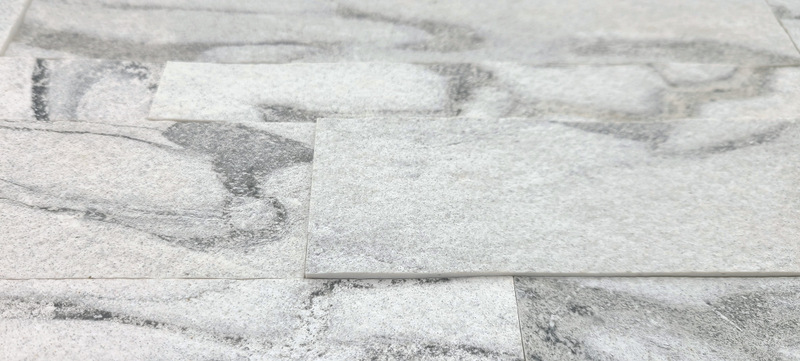1. PREPARATION
If you are looking to start your own peel & stick stone veneer project, here is everything you need to know to get you started.
Tools and Supplies
- Safety Goggles
- Measuring Tape
- Straightedge (for marking)
- Pencil
- Soft Cloth
- Power Saw/ Table Saw/Chop Saw
- (Dust Mask or Respirator)

Layouts
Before you begin to put up the tiles, we recommend laying out your design on a flat surface, to ensure you like the design, you have enough tiles for your design, and so you can plan around cutouts, corners, and edges.
The two most common layouts are:

Subway

Staggered
2. INSTALLATION
General Pointers & Considerations
Now that you are ready to start installing your tiles, here are some pointers and things to consider (keep in mind the requirements for your desired method):
- Drywall, plaster and smooth tile that are prepared properly will take to the adhesive the best
- Begin with the bottom row, using the bottom left corner as your starting point, working left to right
- If you are creating a backsplash above a counter or appliance, use a level to ensure you are dealing with a flat surface
- Align the tile, and angle it so that the top of the tile is leaning away from the wall
- DO NOT bend tiles
- When you are sure of the placement, apply firm pressure around the entire tile to make sure it adheres properly
- Slower-drying adhesives may need to be held in place a little longer
- The adhesive does not allow for repositioning once the tile is put in place – make sure of placement before adhering tile
Preparing Your Wall
Step 1: Allow tiles and substrate to reach room temperature (65 to 100 degrees F.) before installing
Step 2: Prepare your wall
- Ensure wall is clean, flat, smooth, and dry
- Remove any dust, dirt, grease, etc.
- Use a level to ensure no gaps larger than ⅛”
- Any damages must be repaired and sanded before moving forward
Step 3 (Optional): Prime your wall using oil or latex-based primer

Installation Procedure
Step 1 – Installing the First Tile
Angle the top of the tile away from the wall to ensure it does not adhere before you are ready. You may use the edge of your countertop or floorboard as a guide (if leveled).
Step 2- Continuing the Row
Leave the backing on the remaining tiles to “dry fit” them first before going ahead with the adhesive application and installation. Repeat process until row is complete.
Step 3 – Installing the Second(+) Row
When starting a new row, angle the top of the tile away from the wall (at about 30 degrees), and rest the bottom edge on the top edge of the tile below. When you are ready, slowly press the tile into place, making sure the edges fit tightly together.
3. OTHER IMPORTANT METHODS AND PROCEDURES
Cutting Tiles
If your project requires cutting tiles, here are the recommended tools and procedures for your desired cuts:
Straight Cuts
- Large Tin Snip (recommended)
- Table Saw
- Chop Saw
Cutting Notches
- Combination of large tin snip to cut inwards from tile edge and chisel (with hammer) to cut inner edge of notch
Remember to first mark cuts with a pencil, and sand/bur the edges when finished.

Removing Tiles
If you need to remove a tile, use a hair dryer on a warmer setting, applying heat to soften the adhesive. You may use the back side of a putty knife, slowly applying outward pressure to pry tile off the wall. Keep in mind, the adhesive is not meant to be removed once applied so be very cautious. Small marks or paint chips may occur on the wall, and the removed tile may become unusable.
